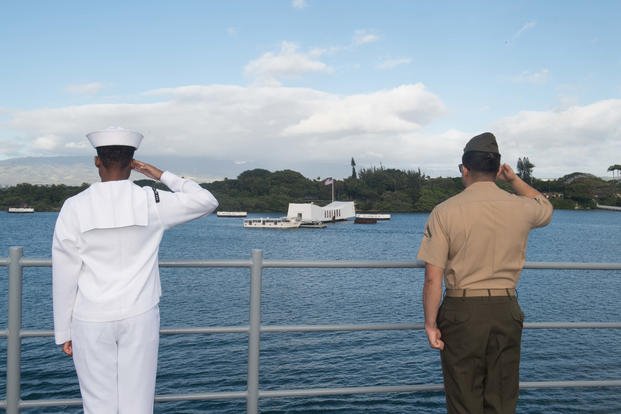Cook 3rd Class Doris Miller is an American hero, the first black sailor to earn the Navy Cross.
On December 7, 1941, under fire, he helped bring the mortally wounded commander of the battleship West Virginia to safety, then wielded a machine gun – a weapon he was not allowed to train with due to his race – to shoot attackers. airplane.
A sign at the Pearl Harbor National Memorial visitor center indicates that Miller died on the USS Liscombe Bay in 1944 during the Battle of Leyte Gulf.
Read more : Navy Admits Pearl Harbor Well Contaminated With Oil; Families are frantic
Miller actually died the previous year, 1943, on the USS Liscoma Bay, at the Battle of Makin Island.
The mistake about an icon for the civil rights movement, whose name will adorn a future Ford-class aircraft carrier, is one of many at the National Memorial in Pearl Harbor that is simply driving historians and aficionados crazy. story.
At least one is working to get them fixed.
“I’ve had an interest in this windmill since 2013,” said former Navy aviator and retired captain Charlie Gillman. “How many thousands of people have to see these things and they’re wrong?”
In addition to Miller’s blunder, there are errors in the photos: a 1941 photo of a Navy PBY Catalina aircraft dated 1943 and a photo of the Japanese aircraft carrier Shokaku from the Battle of Santa Cruz in 1942 which is mislabeled as the Akagi, taken on December 7, 1941.
Some photos lack captions; others are mislabeled or do not properly illustrate the display. And the USS Arizona memorial wall contains five names that have no rank or rate.
“What does it take for these guys to fix these things? Gillman asked during an interview with Military.com. “If they asked for money, maybe they think they’re accusing themselves of screwing it up at the taxpayers’ expense.”
The distinctive USS Arizona Memorial opened to visitors in 1962. Twenty years later, the Pearl Harbor Visitor Center, operated by the National Park Service, opened its doors. But the current errors were introduced in renovations that took place between 2008 and 2010, according to Gillman and historians who have visited the park.
Mike Wenger, who wrote a series of books on the attack on Pearl Harbor for the Naval Institute Press, explains that mistakes can happen for a number of reasons, the first being that the subject matter is extremely complex.
“Documents and photographs in the archives, many of them don’t have proper context. And you have to know a lot about the event in order to interpret them properly,” Wenger told Military.com.
Sometimes there is too much information, he added, making it difficult to verify “little bits of information”.
And finally, many parks and museums simply don’t have military historians on staff who can oversee every detail of exhibits and collections.
“A lot of those decisions — material selection and material interpretation — are sometimes made by committee … and that rarely works out,” Wenger said.
Pearl Harbor National Memorial public affairs officer Emily Pruett said the National Park Service is aware of the issues and Superintendent Tom Leatherman, who took over in October, intends to “correct the mistakes.” .
She added that Leatherman met with Gillman on Nov. 5 and plans to research the items he identified as problematic and make any necessary corrections.
However, she said, the park service “does not have a finalized schedule or cost estimate for the updates at this time.”
The park has had its share of problems. It has suffered from high turnover at the superintendent level, with four acting superintendents since 2020.
In 2018, the National Park Service closed the USS Arizona Memorial for a major renovation to stabilize the monument’s dock system and improve infrastructure – a $2.1 million renovation that was completed in 2019.
Gillman thinks musical chairs and lack of funding have left him woefully neglected.
He wrote to his representatives in Congress and to the Secretary of the Interior to have the mistakes corrected. He lobbied every park manager and hopes Leatherman will be the man to make the changes.
He also set his sights on a bigger effort – to get more money allocated to the park.
Gillman would like to see the interpretive spaces at the Pearl Harbor National Memorial expanded to accommodate a National Park Service warehouse filled with artifacts and materials that are not accessible to the public.
The expansion would require no new construction, he argues, because the park service was awarded a series of buildings on Ford Island a decade ago, the Chief Petty Officers Bungalows, located not far from the memorials of the battleships Oklahoma and Utah.
The century-old homes overlook Battleship Row, “where sailors and Marines swam ashore through flaming oil to safety,” Gillman said.
“From the water’s edge, you can look up and down and see where 12 Medals of Honor have been earned,” Gillman said.
Pruett said the National Park Service is prioritizing projects such as repairing the dock ashore so visitors continue to have access to the USS Arizona Memorial, as well as displaying wartime history. in the Pacific.
She added that “all bungalow rehabilitation options are being considered”.
The National Park Service and Pacific Historic Parks plan to hold events Dec. 5-9 to mark the 80th anniversary of the attacks, which killed 2,390 Americans. Details are available on the park’s website.
Editor’s Note: This story has been updated to correct the opening year of the USS Arizona Memorial.
— Patricia Kime can be reached at Patricia.Kime@Monster.com. Follow her on Twitter @patriciakime.
Related: US sailor showed Japan how to attack Pearl Harbor
Show full article
© Copyright 2022 Military.com. All rights reserved. This material may not be published, broadcast, rewritten or redistributed.

